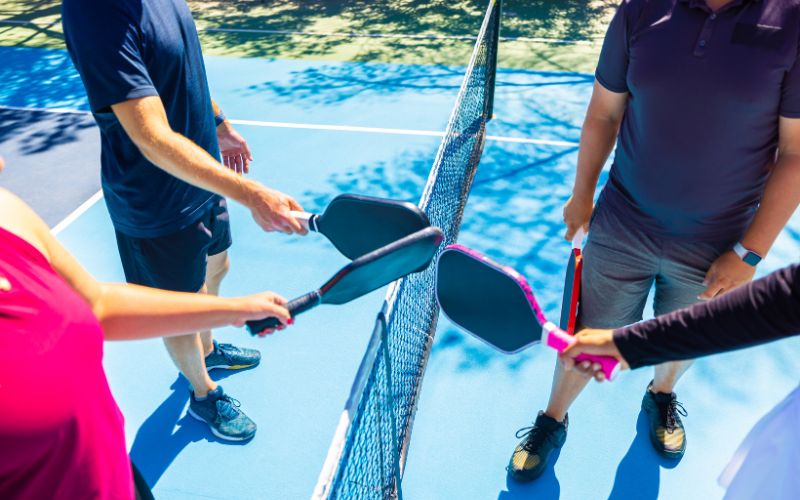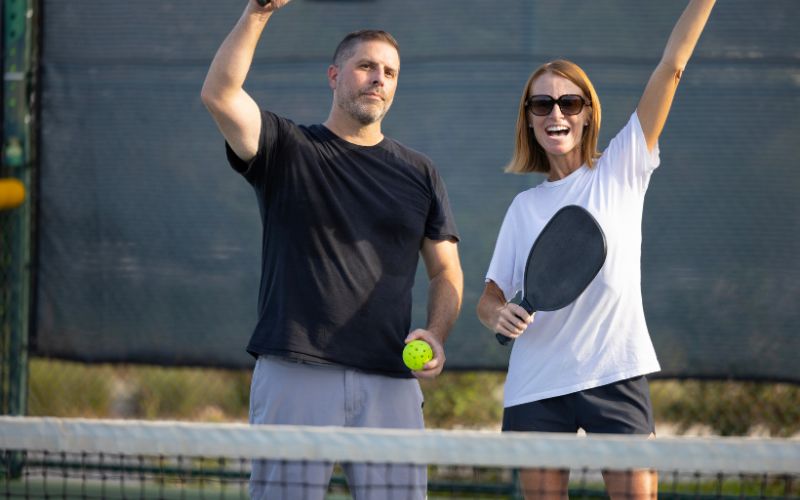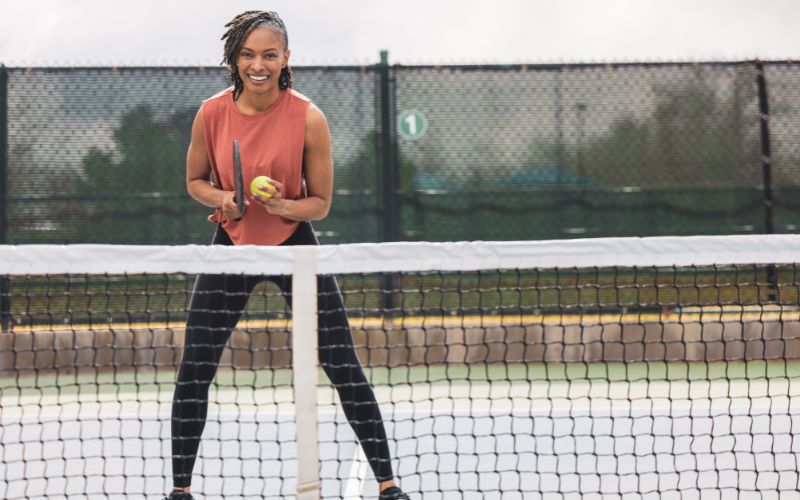Pickleball hand signals play a pivotal role in the game, ensuring effective communication between players. This communication is crucial for strategizing and making quick decisions during gameplay.
Why Pickleball Hand Signals Matter
In the realm of pickleball, effective communication can be the upper hand in securing victories. Understanding and utilizing hand signals can keep players on the same page and prevent misunderstandings.
1. Effective Communication
In the dynamic environment of pickleball, where matches unfold at a rapid pace, clear and concise communication between players is paramount. Hand signals provide a means of non-verbal communication that ensures players stay synchronized and make split-second decisions effectively.
2. Swift Decision Making
Pickleball is a game of strategy and quick reflexes. By utilizing hand signals, players can convey their intentions instantly without relying on verbal cues, thus allowing for rapid decision-making and execution of strategies.
3. Prevents Misunderstandings
Clear and standardized hand signals minimize the risk of misunderstandings between players. This is particularly crucial when making line calls, deciding on switching sides or positions, and executing specific plays or shots.
4. Synchronizing Gameplay
When both partners are on the same page, the game flows seamlessly. Hand signals help in aligning strategies, synchronizing movements, and coordinating plays, ultimately enhancing the overall performance as a team.
5. Adaptability and Strategy
Effective use of hand signals enables players to adapt swiftly to changing situations during a match. Whether it’s altering tactics, switching positions, or indicating specific shots, these signals facilitate the implementation of a well-thought-out game plan.
6. Enhances Focus
Reduced reliance on verbal communication allows players to focus more on the game itself. It minimizes distractions, ensures better concentration, and fosters a stronger connection between partners on the court.
7. Professionalism and Competitive Edge
For professional pickleball players, mastery of hand signals is not just an added skill; it’s a necessity. It sets apart elite players, enhances team coordination, and can be a deciding factor in winning competitive matches.
Disadvantages of Hand Signals
1. Misinterpretation and Ambiguity
Hand movements, if not standardized or agreed upon beforehand, can lead to misinterpretation or ambiguity between players. Different players may have varying interpretations of certain gestures, leading to confusion rather than clarity.
2. Distraction and Misdirection
Excessive hand movements or unclear signals can sometimes distract players, especially when those movements are not directly related to the gameplay. This distraction might affect focus and could result in missed opportunities or errors during critical moments in the game.
3. Communication Limitations
In fast-paced situations, players might find it challenging to observe and interpret hand signals accurately, especially when they are focused on their gameplay. This limitation in communication might hinder quick decision-making and responsiveness on the court.
4. Inconsistency among Players
Not all players use the same set of hand signals. This inconsistency could create confusion, particularly when playing with different partners or teams. It might take time for players to adapt to and understand each other’s unique set of signals.
5. Non-Verbal Communication Limitation
While hand signals are crucial, they only cover a fraction of non-verbal communication. Other cues like body language, eye contact, or even verbal communication often complement hand signals to convey more comprehensive messages. Relying solely on hand movements might limit the richness of communication between players.
Basic Signals: A Player’s Foundation
For beginners and intermediate players, comprehending the foundational hand signals is essential:
1. Open Palm: Signifies a Desire to Switch Sides
When a player raises an open palm, it indicates their intention or readiness to switch positions or sides of the court with their partner. This signal is crucial for maintaining fluidity and adaptability during the game. It’s used when players want to change their positioning on the court for strategic purposes, such as adjusting to the opponent’s play style or maximizing the strengths of each player.
2. Closed Fist: Indicates Staying on the Same Side
Conversely, when a player makes a closed fist gesture, it signals the desire to maintain the current position or side of the court. It’s a clear indication that the player prefers to stay where they are without changing their positioning. This signal is vital for maintaining stability and continuity in the game plan, especially when the current strategy seems effective or when the players have a specific plan in mind for their current positions.
3. Index Finger Up: Signals for a Hard Shot
Raising the index finger signifies the intent to execute a hard shot. It’s a signal for a powerful and aggressive stroke, indicating to the partner to prepare for a faster, forceful shot towards the opponent. This signal can be advantageous for surprising opponents or aiming for a winning shot.
4. Middle Finger Up: Indicates a Soft Shot or a Dink
Contrary to the index finger signal, the middle finger raised signifies a softer shot or a dink. This signal prompts the partner to anticipate a gentle, controlled shot, often used to drop the ball softly over the net, making it challenging for opponents to return. The dink is a strategic move, often employed in the kitchen line to create advantageous positioning.
5. Fingers Spread: Shows Readiness for a Surprise Move
When a player spreads their fingers, it indicates readiness for an unexpected or surprise move. It’s a signal used to communicate to the partner that they’re prepared to execute an unorthodox or unforeseen action. This could involve a variety of strategies, such as a sudden change in direction, a deceptive shot, or an unexpected movement on the court to catch opponents off guard.
Mastering Hand Signals Effectively
Learning how to execute and interpret hand signals effectively can be transformative for pickleball players. It’s akin to developing a language on the court.
1. Establish a set of standardized hand signals within their team:
Additional Strategies:
- Consensus Building: Involve all team members in the decision-making process to create a comprehensive set of signals. Encourage open discussions and feedback to ensure everyone’s input is considered.
- Regular Review: Periodically revisit and review the established signals. As the team evolves or new strategies emerge, adjustments might be necessary to ensure relevance and effectiveness.
2. Practice and reinforce these signals during training sessions or casual games:
Further Steps:
- Variation in Scenarios: Simulate various game scenarios during training sessions to practice using signals in different contexts. This helps players adapt to real-game situations more effectively.
- Role Play: Assign specific scenarios or roles to players during practice matches, requiring them to use signals accordingly. This encourages practical application and reinforces muscle memory.
3. Maintain clear and concise gestures that are easily understandable:
Refinement Techniques:
- Simplicity is Key: Keep the signals straightforward and easily distinguishable. Avoid overly intricate or ambiguous gestures that might cause confusion.
- Feedback Loop: Encourage teammates to provide feedback on the clarity of signals. Adjustments can be made based on feedback to ensure maximum clarity.
4. Use hand signals in conjunction with other forms of communication for a more comprehensive message:
Holistic Communication:
- Verbal Reinforcement: Combine hand signals with verbal cues to reinforce messages. This dual communication approach enhances the comprehensiveness of the conveyed information.
- Body Language: Incorporate consistent body language along with hand signals. Establishing specific postures or movements can further complement the signals and aid in understanding.
5. Remain adaptable and open to adjusting signals for better compatibility with different partners or teams:
Adaptability Strategies:
- Partner-Specific Signals: When partnering with different individuals, be open to discussing and adjusting signals based on their preferences or existing communication habits.
- Consistency in Core Signals: Maintain consistency in core signals across different partnerships while allowing minor adjustments for better synergy with varying playing styles.
The use of hand signals is an integral part of pickleball strategy, allowing for seamless coordination and quick adjustments during matches. They prevent misunderstandings, synchronize gameplay, and enhance focus, ultimately contributing to a team’s success on the court.
However, recognizing the potential disadvantages associated with hand signals, players can proactively address these challenges. By establishing standardized signals within their team, practicing and refining these gestures, maintaining clarity, integrating signals with other communication methods, and remaining adaptable to varying partnerships, players can mitigate potential misunderstandings and enhance the effectiveness of their communication on the court.
Mastering these essential pickleball hand signals – whether it’s indicating a desire to switch sides, execute specific shots, or signal readiness for surprise moves – is not just a skill but a necessity for players aiming for peak performance and success in the dynamic and competitive world of pickleball. Through a combination of practice, consistency, and adaptability, players can harness the power of hand signals to elevate their gameplay and teamwork, ultimately leading to a more rewarding and successful pickleball experience.
Frequently Asked Questions:
1. What are “pickleball stacking hand signals,” and how are they significant in gameplay?
“Pickleball stacking hand signals” refer to specific gestures used by players to coordinate the stacking formation on the court. These signals dictate the positioning of players to optimize court coverage. Employed primarily in doubles play, stacking signals ensure strategic placements, enhancing defensive and offensive capabilities.
2. How do hand signals influence line calls during a pickleball match?
Hand signals play a crucial role in line calls by assisting players in making swift and precise decisions. A designated signal for in or out helps avoid disputes between teammates and opponents, ensuring accurate line calls and fair gameplay.
3. What’s the relevance of “cross court” hand signals in pickleball?
Cross court hand signals communicate a strategic play intending to hit the ball diagonally across the court. This gesture alerts the partner about the intended shot direction, enabling coordinated movement and positioning for an effective cross-court play.
4. How do players effectively use hand signals alongside verbal communication in pickleball?
Combining hand signals with verbal cues amplifies communication efficacy on the court. While hand signals convey specific actions or intentions, verbal communication adds clarity to the strategy or shot type, ensuring a comprehensive message for seamless gameplay.
5. Are there standardized hand signals for different partnerships in pickleball?
While there are common hand signals in pickleball, players may adapt signals to suit individual partnerships. Consistency in core signals across partnerships aids in better understanding. However, minor adjustments might be necessary to synchronize effectively with different playing styles or preferences.






